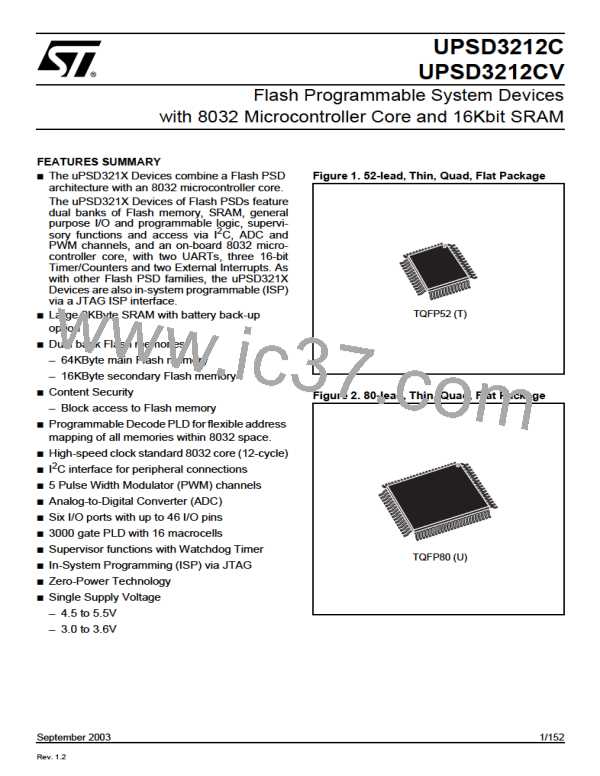UPSD3212C, UPSD3212CV
Data Transfers
Internal RAM. Table 6 shows the menu of in-
structions that are available for moving data
around within the internal memory spaces, and the
addressing modes that can be used with each
one. The MOV <dest>, <src> instruction allows
data to be transferred between any two internal
RAM or SFR locations without going through the
Accumulator. Remember, the Upper 128 bytes of
data RAM can be accessed only by indirect ad-
dressing, and SFR space only by direct address-
ing.
Note: In uPSD321X Devices, the stack resides in
on-chip RAM, and grows upwards. The PUSH in-
struction first increments the Stack Pointer (SP),
then copies the byte into the stack. PUSH and
POP use only direct addressing to identify the byte
being saved or restored, but the stack itself is ac-
cessed by indirect addressing using the SP regis-
ter. This means the stack can go into the Upper
128 bytes of RAM, if they are implemented, but not
into SFR space.
The XCH A, <byte> instruction causes the Accu-
mulator and ad-dressed byte to exchange data.
The XCHD A, @Ri instruction is similar, but only
the low nibbles are involved in the exchange. To
see how XCH and XCHD can be used to facilitate
data manipulations, consider first the problem of
shifting and 8-digit BCD number two digits to the
right. Table 8 shows how this can be done using
XCH instructions. To aid in understanding how the
code works, the contents of the registers that are
holding the BCD number and the content of the
Accumulator are shown alongside each instruction
to indicate their status after the instruction has
been executed.
After the routine has been executed, the Accumu-
lator contains the two digits that were shifted out
on the right. Doing the routine with direct MOVs
uses 14 code bytes. The same operation with
XCHs uses only 9 bytes and executes almost
twice as fast. To right-shift by an odd number of
digits, a one-digit must be executed. Table 9
shows a sample of code that will right-shift a BCD
number one digit, using the XCHD instruction.
Again, the contents of the registers holding the
number and of the accumulator are shown along-
side each instruction.
The Data Transfer instructions include a 16-bit
MOV that can be used to initialize the Data Pointer
(DPTR) for look-up tables in Program Memory.
Table 6. Data Transfer Instructions that Access Internal Data Memory Space
Addressing Modes
Mnemonic
Operation
Dir.
X
Ind.
X
Reg.
X
Imm
MOV A,<src>
MOV <dest>,A
MOV <dest>,<src>
MOV DPTR,#data16
PUSH <src>
A = <src>
X
<dest> = A
X
X
X
<dest> = <src>
X
X
X
X
X
DPTR = 16-bit immediate constant
INC SP; MOV “@SP”,<src>
MOV <dest>,”@SP”; DEC SP
Exchange contents of A and <byte>
Exchange low nibbles of A and @Ri
X
X
X
POP <dest>
XCH A,<byte>
XCHD A,@Ri
X
X
X
24/152

 STMICROELECTRONICS [ ST ]
STMICROELECTRONICS [ ST ]